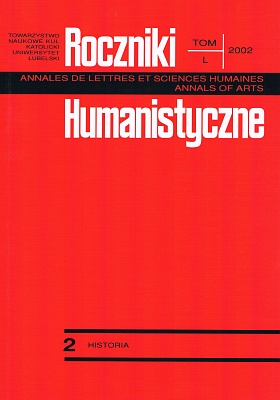Sallust's Works in Anonim Called Gall's Workshop
Abstract
Various studies of the 12th century chronicle written by Anonim called Gall also include to a certain degree the problem of the influence of classical literature on its language. I. Znamirowski's and K. Maleczyński's works devoted to this subject, showing numerous accidental borrowings, induced contradictory opinions among researchers. According to them in Anonim's chronicle references to Caius Sallust Crispus' works appear most often. The chronicler himself refers to one of his works (Bellum Iugurthinum). According to my calculations Anonim included in the chronicle 28 probable borrowings from Bellum Catilinae and 21 from Bellum Iugurthinum. Some of them, like the descriptions of the main characters or battles, are connected with linguistic similarities and they may be credited with the character of Anonim's education. It is similar with the chronicler's speeches for which Catiline's speech recorded by Sallust was the model. It is more difficult to forget about similarities when comparing the events in Numidia after Micipsa's death as described by Sallust and after Władysław Herman's death in Anonim's chronicle. They give the impression that Anonim knew this fragment of Sallust's work well and `directed' the course of events in Poland in a similar way. Also, a comparison between the borrowings used by Anonym and the Czech chronicler Kosmas of Prague shows great quantitative and qualitative differences in using Sallust's works to the chronicler of Poland's advantage. Hence, despite some uncertainty still prevailing, it should be stated that Anonim called Gall knew Sallust's works not only from grammar or rhetoric handbooks; he used his language and imitated his descriptions of various situations. In no way does it depreciate Anonim's contribution but it certainly helps to understand his workshop.
References
Bolaffi E., Sallustio e la sua fortuna nei secoli, Roma 1949.
Buttenwieser H., Popular Authors of the Middle Ages: The Testimony of the Manuscrits, „Speculum” 17(1942), s. 50-55.
Clark D., Rhetoric and Poetry in the Renaissance. A Study of Rhetorical Terms in English Renaissance Literary Criticism, New York 1922.
Deptuła Cz., Galla Anonima mit genezy Polski. Studium z historiozofii i hermeneutyki dziejopisarstwa średniowiecznego, Lublin 1990.
Ghellinck J., L'Essor de la littérature latine au XIIe siêcle, 2d ed, Paris 1955.
Korolko M., Sztuka retoryki, Warszawa 1990.
Kürbis B., Literaturoznawstwo a historiografia średniowieczna, „Roczniki Historyczne” 20(1951/1952), s.167-180.
Labuda G., Źródła historiograficzne kroniki Galla, „Sprawozdania Poznańskiego Towarzystwa Przyjaciół Nauk” 44(1955), s. 21-22.
Leyden W., Antiquity and Authority: a Paradox in the Renaissance Theory of History, „Journal of the History of Ideas” 19(1958), s. 473-492.
Liman K., Epitety dotyczące osób w „Kronice Galla”, w: Ars historica, Poznań 1976, s.341-355.
Liman K., Kilka uwag o topice w „Kronice polskiej” Galla Anonima, „Symbolae Philologiorum Posnanensium” 1(1973), s. 147-164.
Liman K., Porównanie w strukturze narracyjnej „Kroniki polskiej” Anonima Galla, „Eos” 66(1978), s.289-303.
Liman K., Struktura mów przed bitwą w „Kronice polskiej” Galla Anonima, „Symbolae Philologiorum Posnanensium” 6(1983), s.189-209.
Maleczyński K., Wstęp, w: Anonim tzw. Gall, Kronika czyli dzieje władców i książąt polskich, wyd. tenże, w: Monumenta Poloniae Historica, seria 2, t. II, Kraków 1952, s. I-CXIV.
Maleczyński K., Źródła literackie kroniki tzw. Galla anonima, „Sprawozdania Towarzystwa Naukowego we Lwowie” 14(1934), s. 54-57.
Manitius M., Geschichte der lateinischen Literatur des Mittelalters, w: Handbuch der Altertumswissenschaft, Abt. 9, Tl 2, Bd 1-3, München 1911-1931.
Plezia M., Artyzm kroniki Galla Anonima, w: Literatura − Komparatystyka − Folklor, Warszawa 1968, s.23-39.
Plezia M., Kronika Galla na tle historiografii XII wieku, „Rozprawy Akademii Umiejętności. Wydział Historyczno-Filozoficzny”, seria 2, 46(1947), nr 3, s. 1-215.
Plezia M., L'origine de la thèorie du cursus rythmique au XIIe siècle, „Archivum Latinitatis Medii Aevi” 39(1973), s. 5-22.
Pohorecki F., Rytmika Kroniki Galla Anonima, cz. 1, „Roczniki Historyczne” 5(1929), s. 105-69; cz.2, „Roczniki Historyczne” 6(1930), s. 12-75.
Riché P., Instruction et vie religieuse dans le Haut Moyen Âge, London 1981.
Smalley B., Sallust in the Middle Ages, w: Classical Influences on European Culture A. D. 500-1500, ed. by R. Bolgar, Cambridge 1971, s. 165-175.
Stawecka K., Imitatio w literaturze łacińskiej − uwagi praktyczne, w: Munera philologia et historia Mariano Plezia oblata, Wrocław 1988, s. 161-167.
Strzelczy k J., Gerwazy z Tilbury. Studium z dziejów uczoności geograficznej w średniowieczu, Wrocław 1970, s. 206-207 (Monografie z dziejów nauki i techniki, t.LXIV).
Szymański J., Pismo łacińskie i jego rola w kulturze, Wrocław 1975.
Vetulani A., Krakowska biblioteka katedralna w świetle swego inwentarza z roku 1110, „Slavia Antiqua” 4(1953), s. 163-192.
Zathey J., W jakich szkołach uczył się Gall Anonim? „Sprawozdania z Czynności i Posiedzeń Polskiej Akademii Nauk” 53(1952), s. 555-558.
Copyright (c) 2002 Roczniki Humanistyczne

This work is licensed under a Creative Commons Attribution-NonCommercial-NoDerivatives 4.0 International License.





